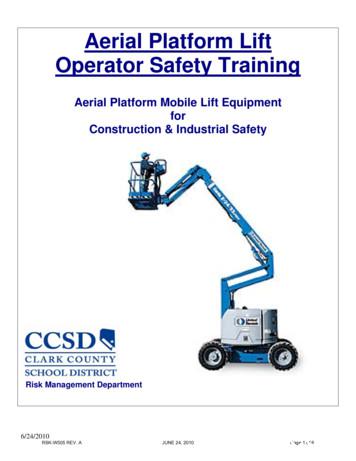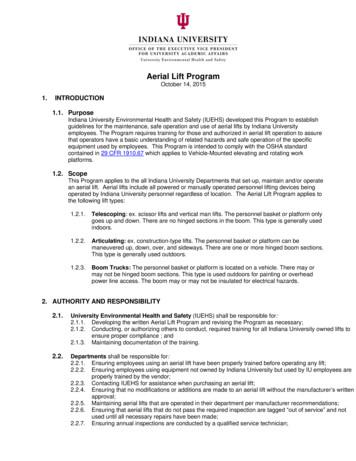Aerial Lift Safety In Construction - OCFL
Aerial Lift Safety inConstructionMichael McCann, PhD, CIHDirector of Safety and ErgonomicsThe Center to Protect Workers’Rightsmmccann@cpwr.com
Deaths from Aerial Lifts inConstruction From 1992-99, there were 26 deaths per yearfrom lifts in construction. 18 per year from boom-supported lifts8 per year from scissor and other verticalliftsThis is 3% of all deaths in construction
Causes of Death from AerialLifts in Construction, 1992-99% o f D eaths43%Electrocutions11%26%Falls44%17%C ollapses/tipovers30%7%Caught in/betw eenBoom -supported lifts 144 deaths#Struck by/againstScissor lifts 64 deaths5%9%#Data for s c is sor lifts do not m eet Bureau of Labor S tatistic s public ation c riteriaS ourc e: U.S . Bureau of Labor S tatis tic s data
Deaths from Aerial Lifts inConstruction, by Trade, 1992-99% o f D e a th s45%E le c tric a l w o rk e rs *22%12%C o n s tru c tio n la b o re rs23%7%P a in te rsC a rp e n te rs#Iro n w o rk e rs* *#16%4%B o o m -s u p p o rte d liftsS c is s o r lifts4%O th e r tra d e s * * *29%38%# D a t a f r o m s c is s o r lif t s d o e s n o t m e e t B u r e a u o f L a b o r S t a t is t ic s p u b lic a t io n c r it e r ia* E le c t r ic ia n s , e le c t r ic ia n a p p r e n t ic e s , p o w e r in s t a lle r s , a n d t h e ir s u p e r v is o r s* * S t r u c t u r a l m e t a l w o r k e r s a n d w e ld e r s a n d c u t t e r s* * * I n c lu d e s p lu m b e r s , p ip e f it t e r s a n d s t e a m f it t e r s , b r ic k m a s o n s a n d s t o n e m a s o n s ,d r y w a ll in s t a lle r sS o u r c e : U . S . B u r e a u o f L a b o r S t a t is t ic s d a t a
Boom-Supported Lifts Electrocutions – almost all due to overhead power lines Falls 1/2 of electrocutions involved body contact with overhead power linesOne-third involved overhead power lines contacting lift booms orbuckets1/2 of fatal falls involved ejection from the bucket after worker or liftswas struck by vehicles, cranes or objects.1/6 occurred while transferring to or from the bucket at a heightCollapses/tipovers 2/5 of deaths involved collapse of boomAlmost one-third were due to tipovers.1/4 involved collapses of bucket
Boom-Supported Lifts (Cont.) Caught in /between Most involved the worker getting caught between the bucket edgeand a roof joist or beam.Struck by/against Mostly involved workers being struck by collapsing materials,girders, etc.
Scissor Lifts Falls 1/5 of deaths involved ejections, after being struck by objectCause of fall unknown in 3/5 of deathsOther causes included removal of chains, standing on orleaning over railingsTipovers Caused almost 1/3 of scissor lift deathsMostly while elevated over 15 feet1/4 of tipovers occurred where lift hit a hole or curb whilemovingElectrocutions 1/2 involved overhead power lines
Renting an Aerial Lift Get maintenance history of aerial liftGet operator’s manual and maintenance manual (if separate)Ensure a detailed maintenance check is done before rentalMake sure operator controls are easily accessible and properlymarked
Operator Training Training must be done by a qualified person experiencedwith the particular lift modelTraining must include:¾¾¾¾¾Nature of electrical, fall, and other hazards involved in operatingliftPrecautions for dealing with hazardsRated load capacity for the lift (including workers, tools,materials, bucket liner, etc.)Manufacturer requirements, as outlined in operator manualDemonstration of skill and knowledge in actual operation of theaerial lift
Qualified Person Definition OSHA 1926.450(b)A qualified person . by extensive knowledge,training, and experience can .solve .problemsrelated to the subject matter .
Maintenance Requirements Training of mechanics should be done by qualified personexperienced with lift modelMaintenance should include:¾¾¾ Knowledge of manufacturer’s maintenance requirementsFrequent inspections of aerial lift by qualified mechanicAt least annual detailed inspections by qualified mechanicInsulated aerial lifts have special electrical testrequirementsDe-energize and lockout/tagout aerial lift beforeconducting maintenance and repairs
Before Operating Aerial Lifts Do not modify aerial lift without written permissionCheck safety devices, operating controls before each useCheck area in which aerial lift will be used for:¾¾¾¾¾ Level surface (Do not exceed manufacturer slope recommendations)Holes, drop-offs, bumps, debris, etc.Overhead obstructions and overhead power linesStable surfaceOther hazardsSet outriggers, brakes, wheel chocks
Preventing Electrocutions Non-electrical workers must stay at least 10 feet awayfrom overhead power lines.Electrical workers must de-energize/insulate power lines oruse proper PPE/equipment.Use insulated buckets near overhead power linesRegularly check insulation on buckets
Preventing Tip-Overs Do not exceed manufacturer rated load capacity limitsDo not travel to job location with lift in elevated position.Set up proper work zone protection when working neartrafficPositioning of lifts¾¾¾¾¾ Do not drive near drop-offs or holes.Do not raise platform on uneven or soft surfaces.Do not drive onto uneven or soft surfaces when elevated.Do not raise platform on slope or drive onto slope when elevated.Do not raise platform in windy or gusty conditions.Avoid excessive horizontal forces when working onelevated scissor lifts
Fall Protection OSHA regulates aerial lifts as scaffolds¾¾¾ 1926.453 Aerial Lifts only applies to bucket trucksFall protection is required (full body harness with lanyard or body beltwith 2-foot lanyard as restraint device)OSHA does not require harnesses and lanyards on other boom lifts andscissor lifts if there are guardrailsFall arrest systems (harness plus lanyard to stop a fall)¾Can tip over some boom lifts and scissor lifts due to fall stopping force Fall restraint systems intended to prevent falls are preferred¾ e.g. Full body harness plus lanyard designed for size of lift platformAlways close entrance chains or doorsStand on floor of bucket or lift platform¾Do not climb on or lean over guardrails
This research was funded as part of a grant to the Center to Protect Workers’Rights (CPWR) from the National Institute for Occupational Safety and Health,NIOSH (NIOSH grant CCU310982). The research is solely the responsibility ofthe authors and does not necessarily represent the official views of NIOSH.CPWR is the research, development, and training arm of the Building andConstruction Trades Department, AFL-CIO.Section 7
Before Operating Aerial Lifts Do not modify aerial lift without written permission Check safety devices, operating controls before each use Check area in which aerial lift will be used for: ¾ Level surface (Do not exceed manufacturer slope recommendations) ¾ Holes, drop-offs, bumps, debris, etc. ¾ Overhead obstructions and overhead power linesFile Size: 465KB
Jan 03, 2018 · flying squirrel moose cut moose bobcat glades runner up porcupine run deer round-a-bout cub carpet low road bobcat chute bus lot lot 3 lot 2 lot 1 lot 4 lot 5 lift e / face lift lift a / mixing bowl lift e / face lift lift b / bear lift lift k / cloudsplitter gondola lift h / mountain run lift i / freeway lift lift g / little whiteface lift g .
Aerial Lift Safety Program. Provide specific operational training for each aerial lift. Observe the operation of aerial lifts, and correct unsafe practices. 6.3 Operators Read the Aerial Lift Safety Program. Complete the Daily Pre-Use Inspection Che
Aerial Platform Lift Operator Safety Training Aerial Platform Mobile Lift Equipment for Construction & Industrial Safety Risk Management Department 6/24/2010 RSK-W505 REV. A JUNE 24, 2010 Page 1 of 6. QUICK CARD TM Aerial Lifts Safety Tips Aerial lifts
Prior to operating an aerial lift, the employee shall perform a pre-operation safety inspection as follows using the appropriate Aerial Lift Inspection Checklist in Appendix B. 3.2.1. The inspection must be made daily or when the aerial lift is used; 3.2.2. When aerial lifts are used on a r
Aerial Lift Stability . safety standards related to aerial/scissor lifts. SCOPE . used in construction/industry. Vehicle Mounted Aerial Lift / Bucket Truck . The lift platform is an integral part of
with an emphasis on aerial lift and other large equipment or vehicle maintenance. 6) Describe your proposed approach and methodology for aerial lift and other large equipment or vehicle maintenance. 7) Please describe your experience with aerial lift and other large equipment or vehicle maintenance, especially for public sector clients.
Aerial Lift Safety Program Original Date of Issue: 01/2013 Reviewed 01/13 Revised 01/13 Overview Aerial lifts are commonly used in construction, inspection, athletic events and repair services to lift University employees to an elevated work position. Prop
Jack Heifner is best known for his play Vanities, wh ich ran for fi ve years in New York and became one ofthe longest running plays in off-Broadway history. His is also the author ofPatio/Porch, Natural Disaster, Running on Empty, Bargains, Boys'Play, Home Fires, Heartbreak, Comfort andJoy, The Lemon Cookie, DwarfTossing and over thirty other plays produced in New York, Los Angeles and .























